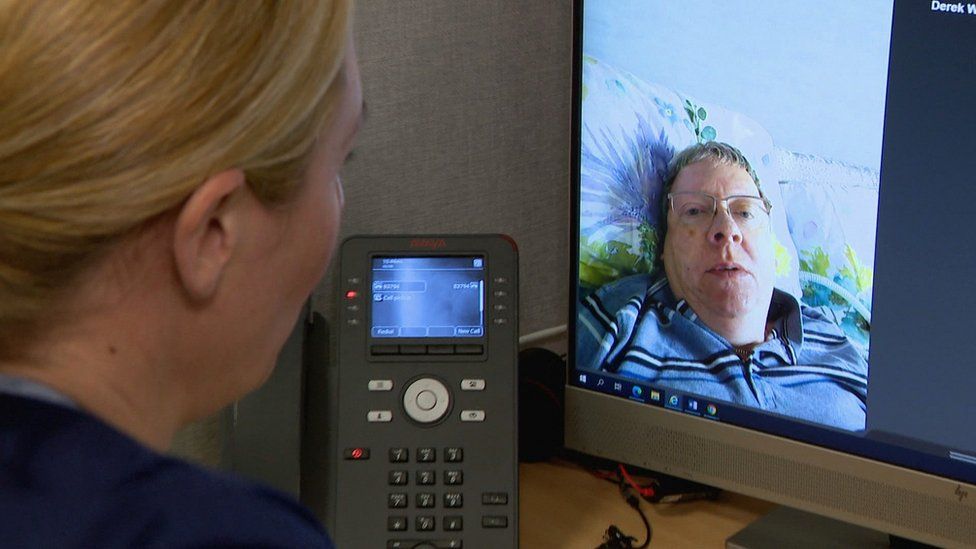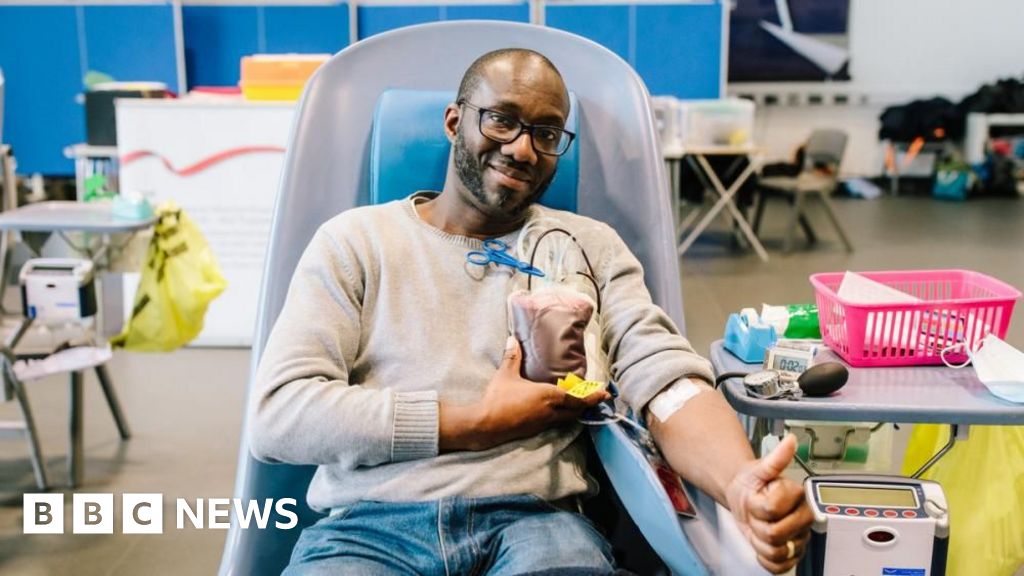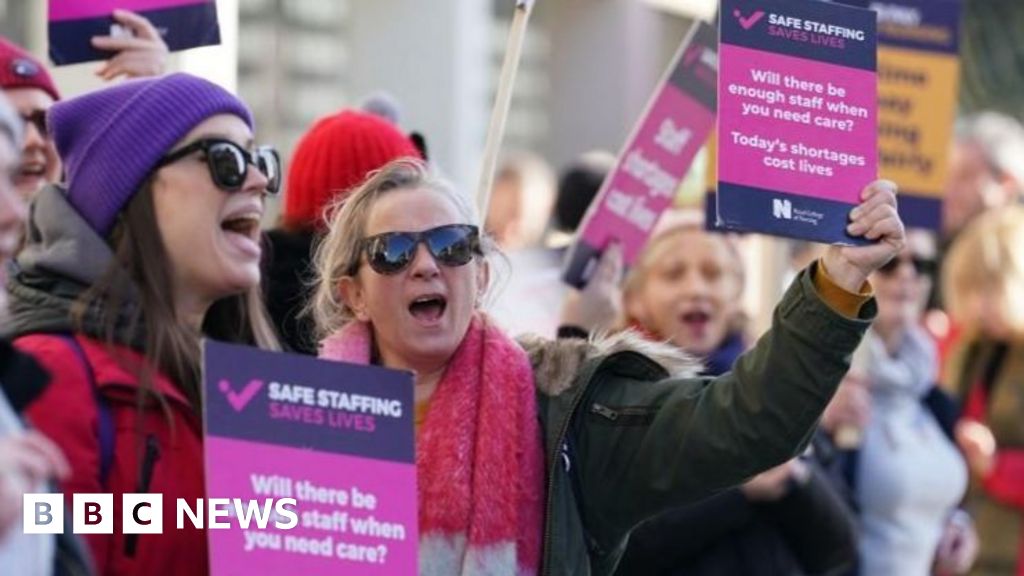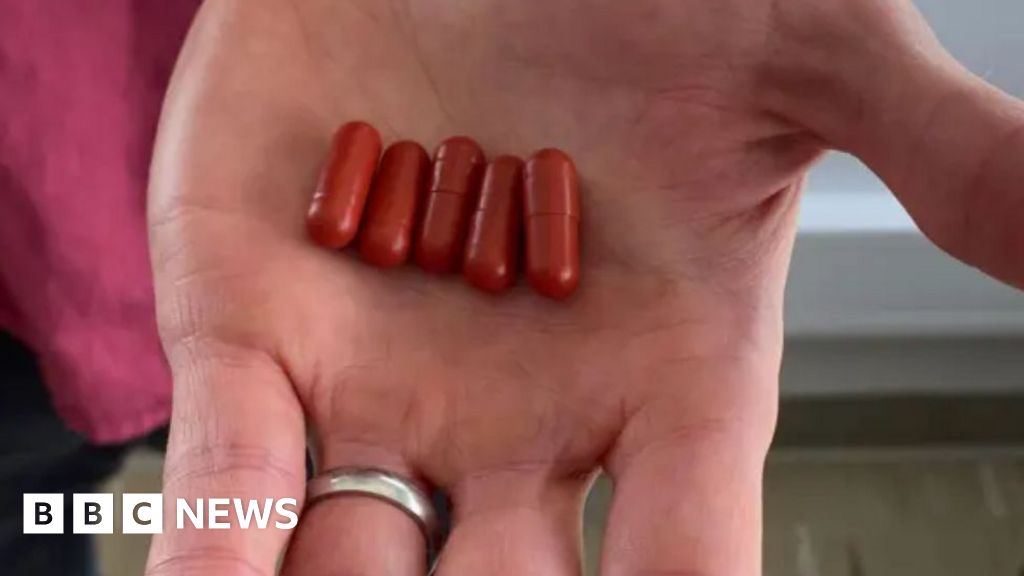ARTICLE AD BOX
By Claire McAllister
BBC Scotland health producer

Nurse Pauline Kerray uses the NHS Near Me video call system to chat to Derek White at his Uddingston home to determine if he needs to make the 13-mile trip to the QEUH emergency ward in person
Scotland's emergency departments are under enormous pressure, with record numbers of people having faced long waits.
In a bid to reduce waiting times, a virtual A&E is being used for people who call NHS24 who might need emergency department treatment.
The goal is to get patients seen by the most appropriate part of the health service and stop overstretched A&Es being the first port of call for people.
Derek White is one of an increasing number of patients being asked to have their injuries initially assessed over a video call by nurses with A&E experience.
He winces as he describes the "excruciatingly sore" back pain caused by lifting heavy stones in the garden of his Uddingston home.
"It's so bad that I'm using all the strength in my arms to lift myself up," he says.
"I take a few intakes of breath to get myself up."
Pauline Kerray is part of the team which carries out virtual consultations with patients
Nurse Pauline Kerray - who is 13 miles away from Derek in Glasgow's Queen Elizabeth University Hospital (QEUH) - listens carefully and offers the 60-year-old advice which includes using painkillers, a hot water bottle and getting lots of rest.
Figures for NHS Greater Glasgow and Clyde show that 30% of people who used the programme were able to get advice and stay at home and did not need to go to A&E in the days that followed.
Derek told BBC Scotland he found the service "pretty thorough".
He says: "I certainly couldn't have done the whole getting up and getting to A&E, I think there would've had to have been an ambulance."
Helping patients and preventing both an unnecessary hospital visit and ambulance callout is the goal of Ms Kerray, lead advanced emergency nurse practitioner on the NHS Greater Glasgow and Clyde programme.
She says: "This is not about stopping people coming in.
"Having had to work in a busy A&E at a time when waiting times were over four hours and you were redirecting patients from a front door when they've taken three buses across Glasgow - that's heart-breaking.
"But now actually speaking to somebody while they're still in the comfort of their own home and you're able to give them advice and say, if this doesn't work call us back - I think this is a positive move forward for patients."
The real problem for emergency departments right across Scotland just now is what staff call "exit block".
There are too many sick patients who have come to A&E and need admitted for further treatment.
Last month, more than 3,500 people spent more than 12 hours in an emergency department. Compare that to April 2019 - the year before the Covid pandemic - and that figure was 301.
Much of that pressure is down to a lack of available beds across the hospital.
Pressures on social care and more seriously ill patients requiring longer hospital stays are among the reasons we are seeing bottlenecks in emergency departments across the country.
Initiatives like the video call system, which is being used at health boards across Scotland, are no silver bullet - but the hope is they can help the people who turn up at A&E who may receive better treatment elsewhere.
The government says tackling long waits in emergency departments is a priority, but getting people used to getting medical advice over a video call instead of face-to-face may take some time to become commonplace.
Pauline says that creating links into different hospital departments means they can also help patients bypass A&E and get straight to specialist care.
For example, the video call team has referred patients with eye complaints to local opticians and patients with possible blood clots in their legs directly to the ambulatory care service, which aims to assess and treat patients without the need for an overnight stay.
Angela Ray, an advanced paediatric nurse practitioner with the virtual consultation team, says there are a lot of injuries that do not really require an A&E visit.
Angela Ray, an Advanced Paediatric Nurse Practitioner, says the video calls can prevent wasted trips to A&E and get patients treated quicker
She says, "I could probably see 10 head injuries a day and I'm not concerned about any of them.
"So, if these 10 people come through the hub that is 10 presentations that you can stop coming into the emergency department.
"At first I thought assessing children over a video call wouldn't be the same, but I've adapted the way I work.
"For example, I had a wee girl with a hand injury and I was like, let's bake a cake, so we put the hand in stirring so that gives me the opportunity to see range of movement and how well the child was doing."
The Scottish government has a target of dealing with 95% of patients who come to an emergency department within four hours. But figures for April this year show the Scotland-wide rate was at 72.1% and for the QEUH it was just 46%.
Pressures at A&E take their toll on staff and patients says Dr Alan Whitelaw, a consultant in emergency medicine at QEUH
Dr Alan Whitelaw, a consultant in emergency medicine at the hospital, said one of the biggest issues was a lack of bed capacity and this is true across Scotland.
He said: "I think I can probably speak for most departments, if not all, in the country and say that in the 20 years that I've been doing this, this is by far the most pressure we've ever been under.
"Obviously, the NHS has been through a period of huge change and upheaval because of Covid. But as we're coming out the other side I think some of the frailties that existed before have come to bite us.
"I think it's going to be difficult - even to get back to where we were three or four years ago seems like that would be fantastic right now. We have to hope they'll improve. It's hard to see how things can get any worse."
A Scottish government spokeswoman said: "We want people to get the right care in the right setting and for many A&E will not be the most suitable place for their healthcare need.
"People should consider whether their condition is an emergency, such as a stroke, heart attack or major trauma, before going to A&E. Local GPs can be contacted during the day for non-critical care, as well as local pharmacies.
"The NHS 24 telephone service is available on 111 for non-emergency inquiries."

 2 years ago
80
2 years ago
80








 English (US) ·
English (US) ·